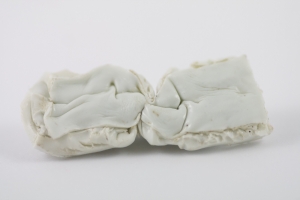
This off-white, toothpastey blob of material is celluloid, the first commercial, man-made plastic, developed in the 1860s from cotton. Early plastics like Parkesine, celluloid and Bakelite were developed as substitutes for their increasingly scarce and expensive precursors: natural polymers like ivory, tortoiseshell and horn. At that time, elephants and turtles were facing extinction as a result of increasing demand for industrially produced piano keys, billiard balls and hair combs. In response to this environmental and economic problem, an American billiard ball manufacturer offered a reward for the development of a substitute for increasingly scarce elephant ivory. Amateur inventor John Wesley Hyatt took up the challenge and experimented with cotton wool and nitric acid, ending up with this malleable and versatile material that could hold its shape once cured.
Unfortunately, as our director Mark Miodownik has explored in his books and TV programmes, celluloid was quite a poor substitute for ivory billiard balls. Not only did it not sound right when the balls knocked together, but it was also reported that these imitation billiard balls had a tendency to spontaneously ignite, or at least make a sharp cracking noise that caused people to reach for their guns when they collided at high speed (Stuff Matters, 2014).
However, celluloid found another more far-reaching application as a substitute for paper cinema film reels. Celluloid’s strength and malleability meant it could be made into long thin strips, and painted with a chemical that would alter in the presence of light, making it a near-perfect material for the silver screen. Unfortunately, celluloid is also highly flammable: its constituent ingredients are also used to make guncotton, a low order explosive. This resulted in a number of celluloid factory fires in the late 1800s and early 1900s, and celluloid was later replaced by more stable and less flammable synthetic plastics.
This sample was made by our director Mark Miodownik as part of his 2012 BBC4 Series How It Works.
Sample ID: 958
Particularities
- State
- Solid
- Compound
- Maker
- Mark Miodownik
- Selections
- Curiosities
- Relationships
- Amateur Inventor | Billiards | Cinema | cotton | Extinction | Flammable | Hair Comb | Ivory | Malleable | Natural | Plastic | Scarcity | Skeuomorph | Sound | Sound of Materials | Substitute | Synthetic | Tortoiseshell | Versatile
Add materials you find interesting to your own selections.
Use the  button to select a material and get started.
button to select a material and get started.



